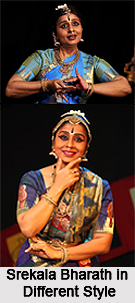 Srekala Bharath, under the guidance of her guru Kalaimamaani Smt. K.J.Sarasa of Chennai was brought about to classical dance. She was then just seven years old and made a prominent impression in the domain of Bharatanatyam. Smt. K.J.Sarasa , guru of Srekala, was one of the front most disciples of the legendary Vazhvoor Ramaiah Pillai. Thus training from this gharana admits the fact that Srekala Bharath will also assimilate the Vazhvoor style of dance. Srekala, after her arangetram in the 1972, in an intense manner practiced to adopt the skillfulness on a strong foundation. She is well admired for her skillful footwork and inventive recitals. Her career has been marked as a march from one thriving execution to another.
Srekala Bharath, under the guidance of her guru Kalaimamaani Smt. K.J.Sarasa of Chennai was brought about to classical dance. She was then just seven years old and made a prominent impression in the domain of Bharatanatyam. Smt. K.J.Sarasa , guru of Srekala, was one of the front most disciples of the legendary Vazhvoor Ramaiah Pillai. Thus training from this gharana admits the fact that Srekala Bharath will also assimilate the Vazhvoor style of dance. Srekala, after her arangetram in the 1972, in an intense manner practiced to adopt the skillfulness on a strong foundation. She is well admired for her skillful footwork and inventive recitals. Her career has been marked as a march from one thriving execution to another.
A busy dancer, Srekala has performed at the major festivals in India and abroad. A few to mention: The Puri Festival, Mamallapuram Dance Festival, Hampi and Bijapur festivals, Kalidas Samaroh festival at Ujjain, International Snow Festival, Sapporo, Japan,
India Shows at HongKong, Korea and Philippines. In acknowledgement of her contribution to Bharatanatyam, several awards have been conferred to Srekala, such as the title of "Nadanamamani" from Karthik Fine Arts and that of "Shiva Sakthi Natya Chintamani from the Omkar Ashram of Pondicherry. The Ministry of Cultural Affairs, Colombo awarded the Bharatha Ratnam to her and the title of "Kalaimamani", the highest civilian award to a performing artiste was also given by the Government of Tamil Nadu. In elevating the art to contemporaneous relevance, Srekala has been proved to be a consecrated dancer. This devoted dancer dances for the sake of art and has contributed importantly not only through her own performances, but also by examining minutely new avenues of choreography. She has produced a dance ballet mainly on the nine types of devotion of dance. It is considered as evidence to her devotion and passion for Bharatanatyam.
Kodhai Potriya Kannan, Swati Smriti, Annamayya Bhakti Manjari and Thyagaraja Vaibhavam are some of her far-famed solo and ballet thematic presentments. To bestow dance training in the Vazhuvoor style, she has established her own dance school `Thejas`. In May 2001, she was elected as the secretary of ABHAI - Association of Bharatanatyam artistes of India. Srekala received the Nritya Kala Shiromani award in December 2001.
She is being known for his strict adherence to tradition. In the contemporary themes also she followed the tradition.



















